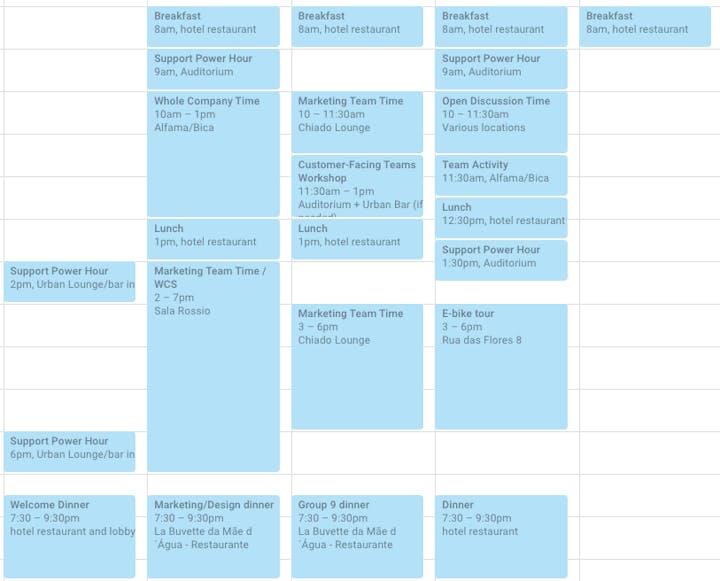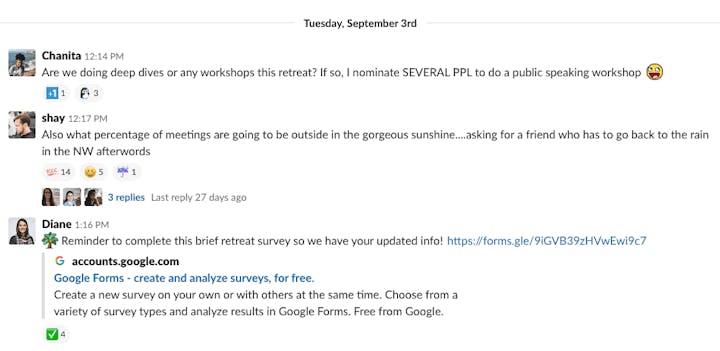How to Plan a Fun and Productive Company Retreat


The company retreat, often imagined as a weeklong playground of corporate hedonism and zero work, is slowly getting a much-needed makeover.
At Help Scout, we’re rethinking how to plan a company retreat — the goal is to produce thoughtful, effective getaways that spur productivity, juice up morale, and lead to more meaningful relationships.
These details are critical whether you work together in an office or you’re a remote team, like we are.
Try the customer support platform your team and customers will love
Teams using Help Scout are set up in minutes, twice as productive, and save up to 80% in annual support costs. Start a free trial to see what it can do for you.
Try for free
Why plan a company retreat?
Like other remote companies, we rely on many tools to stay connected and organized as we work. But ...
There’s a special magic that happens when we get the entire team together in a room, on a ski slope, or in a bowling alley on our retreats.
Figuring out each other’s personalities face to face offers helpful information to take back when we resume our largely text-based communication. For non-remote teams, an offsite retreat can help shake up the status quo and get creative juices flowing in an environment that’s not the same old office.
Now that more than 100 people work at Help Scout, our company retreats require more planning since the first time a dozen or so of us gathered together in Provincetown, Mass. Everything requires more consideration — timing-wise, for example, the first week of the month isn’t good for finance, while the last week of the month isn’t good for sales. Some team members may be planning their sabbatical or parental leave. There’s a lot that goes into it, so we generally start planning our retreats nine months in advance!
Planning a company retreat that leaves your team invigorated has its challenges, and with several under our belt, we’ve learned a great deal.
How do you plan a retreat?
One of the most useful things I learned as a high school teacher was the concept of differentiated instruction — not every student learns the same way, so the act of teaching benefits from a variety of approaches to present any given topic.
How do you take 100 people with different tastes, requirements and preferences and successfully plan for food, fun, and ways to recharge that they’ll all enjoy? Much like differentiated instruction, differentiated company retreat planning is the best approach — providing variety and choice will result in maximum happiness and a trip everyone will remember.
With this philosophy in mind, let’s talk details: setting a budget, picking a location, finding a place to stay, and structuring those memorable activities.
(One thing to note: Organizing and executing a company retreat is equal parts exhausting and exhilarating. If you don’t have the bandwidth internally, consider going with a company like Moniker, who can help with all the research, logistics, planning and even on-site staffing of your next retreat.)
How much does a company retreat cost?
Retreats don’t have to break the bank. To determine a budget, consider your company size and where you want to go. If your company has never retreated before, start small. You can save a considerable amount by traveling in the off season, and staying somewhere close to a major airport.
For our first retreat in September 2014, we rented a few houses and kept things simple. After that, we stepped it up and stayed on a ranch in Colorado. For our fall retreat this year, to a resort in Cancún, Mexico, we aimed at keeping our budget under $2,300 per person. We carefully estimate flight costs, accommodations, meals and incidentals, all the way down to AV costs, airport transfers, gratuities … and of course, swag!

Our design team always creates memorable (and adorable!) company retreat swag — we’ve done T-shirts, pins, totes, backpacks, temporary tattoos and other fun mementos.
Buffer, another remote company, projected their ninth retreat (to Singapore) would cost $380,067 for 85 team members, plus their partners and children.
If you’re a remote company and still concerned about the price tag, keep in mind that it’s less expensive to fly everyone someplace twice a year than to pay rent on an office space year-round.
How long should a company retreat last?
Our first four retreats were four-day, Tuesday-Friday affairs. We thought this would be enough time to work, bond and respect work-life balance. But while four days is probably sufficient for co-located offices, our remote team is spread out all over the world, which meant the first day was always lost to travel.
Nowadays, we schedule a full workweek retreat (Monday-Friday). Adding a designated travel day and three full days at our offsite was the perfect amount of time to get work done and have enough time to get to know each other.
How do you choose a company retreat location?
While it might seem appealing to travel to a five-star tropical resort that’s only accessible by helicopter, we’ve learned that getting to the retreat location is as important as the retreat itself. Finding company retreat locations near major airports and within a short drive helps your teammates feel relaxed and happy they’re about to spend time with their colleagues. And you’ll never know until it’s too late that someone on your team might get motion sickness, so the less time on a bus, the better.
Remember that traveling during the shoulder season can save you some dough, and that if you have teammates all over the world, it’s nice to switch up locations — that way, everyone takes turns having to take longer versus shorter flights!
One other factor we try to be aware of is that politically, we need to ensure all of our team members can travel safely and be admitted without hassle to the countries where we’re traveling. Think about whose economies you’re going to support and make sure your team feels safe and comfortable traveling to those regions.
What kind of accommodations are best for corporate retreats?
While they’re costlier, top-notch accommodations set the tone for your retreat. An impeccable hotel that pays attention to detail will wow your employees, raise morale from the start, and encourage everyone to bring their A-game.
While it’s ideal to scope out accommodations ahead of time, that won’t always be doable, so relying on travel-review sites such as TripAdvisor and Yelp are essential. We try to book entire hotels, estimating how many rooms we’ll need based on our hiring plan. We prioritize allowing every team member a private room. It increases the budget, but we’ve found that our team appreciates some quiet time and the chance to recharge alone.
Details are important to us — we want to treat our team just as well as we treat our customers. Does the hotel have plenty of breakout spaces for team meetings? Can you use Google Earth to take a virtual walk from the closest metro stop to the main lobby entrance, so you can give your team members all the travel instructions they might need? Our goal is to let everyone have a nice time and not have to worry about anything.
How should you structure your company retreat agenda?
Unless your team is comprised entirely of extroverts, it’s important to schedule time to bond together as well as unstructured free time. Spending several high-energy days with your colleagues has the potential to feel draining, so providing your team with choices in how they spend their time will add to employee delight. Just be crystal-clear on which activities are mandatory and which are not.
Here is an example of a Help Scout company retreat agenda, from our Spring 2019 trip to Lisbon, Portugal.

While the main reason we retreat is for everyone to build deeper relationships, we also talk shop. We nominate individuals to give deep-dive talks on their work. We structure time for each team to meet, as well as cross-team meetings. Scheduling team-meeting time is also great for big-picture visioning and strategizing, which energizes everyone to return to their remote offices with refreshed goals and attitudes to execute.
But all work and no play makes Jill a dull girl. In between the meetings and meals, plan a few non-business activities for your colleagues to participate in. Think of activities that are exciting, potentially out of the ordinary, and also accessible to the greatest number. No, I’m not talking about trust falls or mandatory karaoke. In the past, we’ve coordinated bike rides, beer and wine tastings, soccer games, museum visits, cooking classes, street art tours, treasure hunts, game nights, and all kinds of other fun stuff!
While there’s nothing wrong with offering opportunities to imbibe, don’t make assumptions that your team is full of boozehounds. Trust your team to make adult decisions, but also set everyone up for awesome, safe fun by capping open bars or handing out drink tickets. In the event you do have people who are dying to sing karaoke, make it happen, but make it optional.
Figuring out group meals can be one of the most daunting yet exciting parts of retreat planning. We’ve found that surveying everyone on your team before the retreat about food allergies or dietary restrictions goes a long way to ensure restaurant selections meet everyone’s needs. And it’s helpful to have these on file going forward (in case you someday want to send cupcakes to Megan in Italy, you’ll know they have to be vegan!).

In addition to all-hands meals in the hotel, we also break the team up into dinner groups and send them out to various restaurants around the city, so everyone gets a chance to interact with folks from different teams.
When you’re planning a company retreat, there’s no such thing as over-communication
Getting our entire team together on the right day and time takes organization and patience. We invite everyone to a retreat-specific channel in Slack — that’s where we share all the pertinent info like location, dates, tentative schedule, and so on. It’s also a great way to build excitement beforehand and get the whole team invested in having a fun and productive time together.
Here is a conversation from our retreat-related Slack channel.

We ask team members to research their own flights and run their proposed itinerary past planners from our People Ops and Customers teams. Once they have the go-ahead, they can purchase the ticket on their own company credit card. That way, everyone is able to find flight schedules that work best for them and purchase them easily.
As your company gets larger, getting your team where they need to be can feel like herding cats. We send Google Calendar invites to everyone, and we post all pertinent retreat info in our internal wiki (we use Slab). Part of the differentiated retreat planning involves sending information via various channels, so the more the better — reaching people in a variety of ways ensures everyone gets to the right place at the right time.
Before the retreat, we host a “retreat Q&A” for all retreat newbies. We cover what to expect and let everyone ask questions, and we pair them up with a Help Scout veteran as their “retreat buddy” so they have a point of contact before and during the event. During the retreat, Slack can be a huge help to rally everyone in the lobby or to send schedule updates in real time.
The post-retreat survey
As soon as your retreat is over, solicit feedback from your team to improve the next one while showing your team you value its input. We run a short survey after every retreat, and that’s one of the first things we look at as we start planning the next one. Don’t take it personally if some people don’t love every part; differentiated retreat planning requires being at peace with the fact that everyone will enjoy things differently, and that’s great.
When planned with intention and consideration, a company retreat provides an authentic opportunity to boost employee happiness and build a strong, connected culture — and it shouldn’t require a six-figure spa bill to pull it off.
Editor’s note: This post was originally published in February 2016 and has been updated for freshness, accuracy, and comprehensiveness.
The Supportive Weekly: A newsletter for people who want to deliver exceptional customer service.
